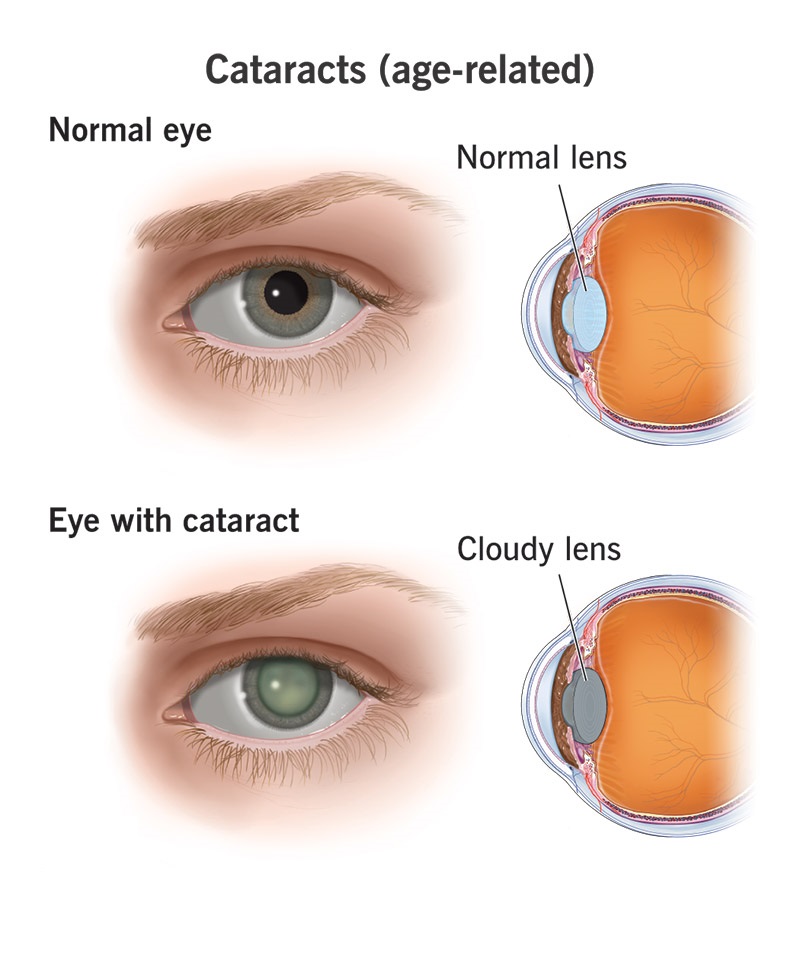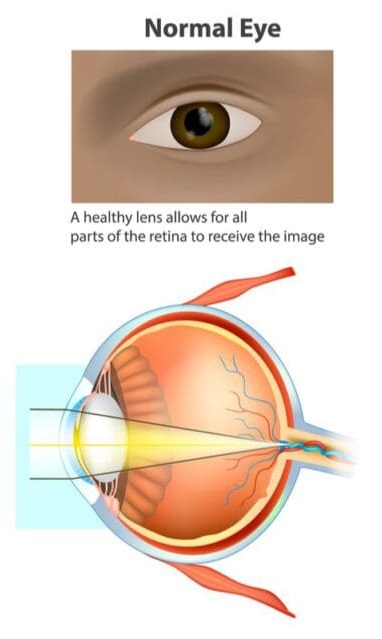Cataracts
Cataracts in the eye
Cataracts are an opacity in the eye’s lens, where it becomes opaque or foggy, leading to impaired vision. This condition typically develops gradually and is more common with aging. It occurs when the proteins in the eye’s lens change, leading to blurring and reduced clarity of vision. Cataracts can significantly affect the quality of life, making daily activities such as reading and driving difficult.
Causes of cataracts in the eye
The main cause of cataracts is aging. As one ages, the lens proteins start to change and become less transparent. Other factors that may increase the risk of developing cataracts include prolonged exposure to sunlight without protection, diabetes, smoking, eye injuries, and the use of certain medications such as cortisone. Genetic factors can also play a role.

The symptoms of cataracts include a gradual deterioration in vision, blurry vision, difficulty seeing in bright light or at night, an increased need for light when reading, seeing halos around lights, changes in color vision, and frequent changes in eyeglass or contact lens prescriptions.
Cataracts cannot be treated with medication. The only effective treatment for cataracts is surgery, where the cloudy lens is replaced with a clear artificial lens.
Surgery is recommended when the symptoms of cataracts significantly impact a person’s daily quality of life. The decision to undergo surgery is based on the extent to which cataracts affect daily activities.
Cataract removal
Cataracts cannot be treated with medication. The only effective treatment for cataracts is surgery, where the cloudy lens is replaced with a clear artificial lens.
Steps of Cataract Surgery
The surgery is usually quick and performed under local anesthesia. The surgeon makes a small incision in the eye and uses a technique known as phacoemulsification to break up and remove the cloudy lens. An artificial lens is then implanted in the same place. The procedure can be performed using different techniques such as phaco, and the method varies based on the condition and the doctor’s recommendation.
Post-Cataract Surgery Care
After the surgery, patients are advised to rest and avoid activities that may exert pressure on the eye. The doctor may prescribe eye drops to aid in healing and reduce inflammation. Typically, patients can resume most of their daily activities within a few days, but full recovery may take a few weeks.

The Difference Between Types of Artificial Lenses
There are several types of artificial lenses that can be used in cataract surgery. These include multifocal lenses, which allow for clear vision at multiple distances, and monofocal lenses, which improve vision at a single distance (usually for distance vision). The type of lens is chosen based on the individual’s vision needs and lifestyle.
Symptoms After Cataract Removal Surgery
After surgery, it is common for patients to experience some redness and irritation in the eye. They may also experience temporary sensitivity to light. These symptoms usually improve within days to weeks.
Eye Inflammation After Cataract Extraction
Eye inflammation after cataract surgery is a rare but possible complication. It can occur due to an infection or an allergic reaction to some of the medications used during or after the procedure. Symptoms of eye inflammation include redness, pain, itching, and increased tear production. Eye inflammation requires immediate treatment by an ophthalmologist to avoid complications.
Post-Cataract Removal Surgery Instructions
After the procedure, patients are advised to avoid rubbing the eye and exposure to dirty water or dust for several weeks. They should follow the doctor’s instructions regarding eye drops and medications. Patients are also advised to avoid strenuous activities and sudden bending to prevent pressure on the eye.
Typically, cataract removal does not alter the external shape of the eye. However, some patients may notice minor changes in the appearance of the eye due to the implanted artificial lens or due to a reduction in swelling or redness that was present before the surgery.
Vision usually stabilizes within a few days after the procedure. Patients may notice an immediate improvement in vision, but the final vision may take some time to fully stabilize. This depends on multiple factors, including the overall health of the eye and the type of implanted lens.
Cataract surgery is typically quick, taking about 10 to 15 minutes per eye. It is usually performed under local anesthesia, and full anesthesia is not required in most cases.
Before the procedure, the doctor conducts comprehensive eye exams to determine the appropriate size and type of artificial lens. The patient may be asked to stop taking certain medications and follow specific instructions to reduce the risk of infection.
Cataract surgery is usually an outpatient procedure, meaning patients can go home on the same day of the surgery. In most cases, a long hospital stay is not required.
Cataract surgeries are usually performed on one eye at a time. Doctors prefer to have a recovery period between the two procedures to assess the results and ensure there are no complications before proceeding with the surgery on the other eye.
The success rate of cataract surgeries is very high, typically ranging from 90% to 98%. However, as with any surgical procedure, there is always a risk of complications or the need for additional surgery.
Genetic and Infectious Factors of Cataracts
Cataracts, or cataract formation, may have genetic factors, especially if they occur at an early age. However, they are most commonly a result of aging. Cataracts are not contagious and cannot be transmitted from one person to another.
Post-Cataract Surgery Guidelines
It is crucial to follow the doctor’s instructions precisely, which usually include using eye drops, avoiding rubbing the eye or exposing it to water and dust, and avoiding strenuous activities for a few weeks after surgery.
Improvement After Cataract Surgery
Improvement in vision can occur within a few days after surgery, but it may take several weeks for vision to fully stabilize. This depends on multiple factors, including the overall health of the eye and the type of implanted lens.


Cataract Surgery in Children
Cataract surgery in children is performed in a manner similar to adults, but it may be necessary to implant an artificial lens. The decision depends on several factors, including the child’s age and the eye’s health condition.
Return of Blurry Vision After Surgery
In some cases, blurriness may return due to the formation of a membrane behind the artificial lens. This condition can be treated with a simple laser procedure.
Changes After Cataract Surgery
After the surgery, patients typically notice a significant improvement in vision. They may need to adjust their glasses, or they may find that they no longer need glasses for certain activities.
Risks of Cataract Surgery
Rare risks of the procedure include infection, bleeding, increased eye pressure, or the need for additional surgery. Most of these risks are rare and can be minimized by following medical advice.
Blurry Vision After Surgery
Vision may be blurry immediately after surgery for a short period. However, if it persists or worsens, it is essential to consult the doctor.
Vision Stabilization After Surgery
Vision is expected to stabilize within a few weeks, but this may vary depending on the case.
Cases Requiring Longer Healing Time
Patients with complications or other health conditions may need a longer healing time.
Artificial Lens and Body Rejection
The artificial lenses used in cataract surgery are usually highly compatible with the body and rarely subject to immune rejection.
Difference Between Multifocal Lenses and Other Lenses
Multifocal lenses provide clear vision at multiple distances (near, intermediate, and far), while monofocal lenses provide clear vision at one distance.
Advantages and Disadvantages of Multifocal Lenses
Advantages include reducing the need for glasses. Disadvantages may include seeing halos around lights and a need for an adaptation period.
Working Hours
Saturday
7 pm to 9 pm
Sunday
7 pm to 9 pm
Monday
7 pm to 9 pm
Tuesday
7 pm to 9 pm
Wednesday
7 pm to 9 pm
Thursday
Closed
Friday
Closed
Ramadan Working Hours
Saturday to Wednesday from 9 pm to 11 pm
Location
21st Ismail Ramzy st. – El-Bostan – Heliopolis – 4th floor
01110114354
01222422637
0226331026
(7 pm to 9 pm)
Make Appointment
Always happy to receive your inquiries
